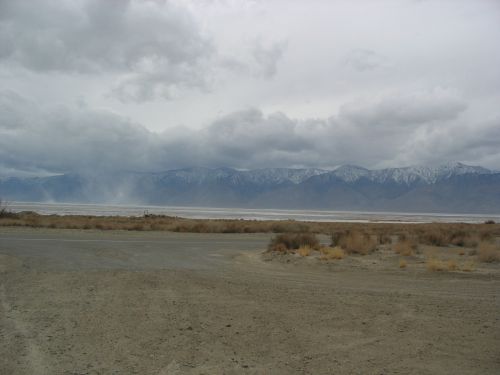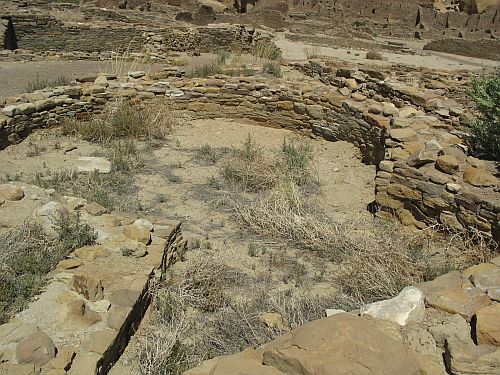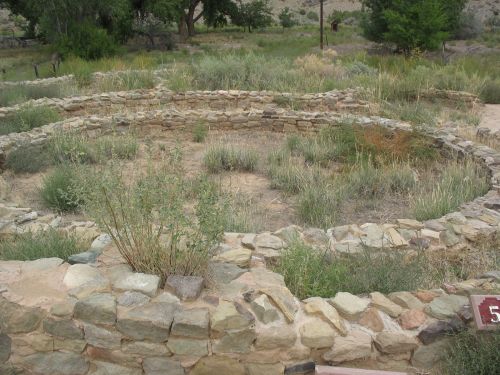The paper I discussed earlier about evidence that corn was imported to Chaco was interesting, but while it provided important information about the poorly understood “Mesa Verdean” period after the fall of the Chaco system it didn’t address the question of food imports during the operation of that system. This has been a topic of considerable debate, and the extent to which corn was being imported to Chaco from outlying areas versus being grown in the canyon itself has major ramifications for which theories about the nature of the system seem most plausible. Luckily, however, that paper was just one in a long series reporting on research done by Larry Benson and others on this topic, and a slightly earlier one by Benson, H. E. Taylor, and our old friend John Stein addresses the question of earlier (and later) periods.
This paper uses the same basic methodology of the other one, based on strontium isotope ratios, and it also attempts to use concentrations of other trace elements to further narrow down source areas for corn cobs from archaeological sites. Unfortunately, however, most of the trace elements the researchers looked at had their concentrations heavily skewed by post-depositional contamination, which made them useless for determining sources. The only elements that seemed to be mostly unaffected by this problem were potassium and rubidium, so the paper uses the ratio of these two elements as an additional marker for places where the cobs may have been grown, although it cautions that it’s not yet totally clear that this ratio is actually as meaningful as the analysis implies.
This study looks at more cobs than the other one. These are from both Chaco and Aztec, and the Chaco ones come from a variety of sources. The most numerous are from Gallo Cliff Dwelling and are part of the large group with nearly identical radiocarbon dates in the late 12th century that was analyzed in the more recent paper. This paper conducts a similar analysis and comes to similar conclusions about the wide range of possible sources for these cobs. This group also includes a few cobs from Pueblo Bonito, Chetro Ketl, and Kin Kletso, although the authors caution that the late dates on these cobs don’t necessarily imply that these great houses were still occupied at this late date; the cobs could also result from people living in small sites like the Gallo Cliff Dwelling dumping their trash in the abandoned buildings. While most of the Chaco cobs come from this narrow time period, and the Aztec cobs (which have not been carbon-dated) likely date from a roughly comparable time as well, some Chaco cobs are dated to both earlier and later times. The later ones, some of which date to the nineteenth century, are presumed to reflect the later Navajo occupation of the area. It’s the earlier ones that are of interest for the light they can shed on the operation of the Chaco system in its heyday.
There are six cobs with carbon dates earlier than the major drought of the mid-12th-century. Five of these come from Pueblo Bonito, and one comes from the Gallo Cliff Dwelling. The Gallo one is puzzling, since all the other Gallo cobs date to much later and cluster tightly together, and the site itself was probably not occupied early enough to account for the early cob. It’s possible that this date is due to something odd going on with the radiocarbon dating, and in any case it seems hard to generalize from, so I’m not going to discuss it further here and will instead focus on the five cobs from Pueblo Bonito.
Four of these come from Room 3; the other one comes from Room 170. These are both interesting rooms in their own right, but first let’s talk about the cobs. Although the authors of the paper classify them only as “pre-AD-1130” (i.e., before the drought that is thought to have coincided with the fall of Chaco), they actually all date considerably earlier than that. The earliest, which unfortunately seems to have been contaminated and thus unusable for the strontium analysis, is from Room 3 and has a calibrated radiocarbon date range of AD 765 to AD 902 with 95% confidence (2σ). The other four are somewhat later and cluster tightly together, with 95% confidence intervals of AD 944–1052 (this is the one from Room 170), AD 892–1034, AD 893–1026, and AD 889–1021. This means that these cobs all date to a period before the Chaco system reached its full florescence, which is generally dated to the late eleventh century. They also seem to date earlier than the expansion of Pueblo Bonito in the 1040s. The 95% confidence interval for the cob from Room 170 does make it possible that it dates to the period of the expansion, but at a lower level of confidence (1σ) it has a tighter range of AD 974 to AD 1040, which means it too probably predates the expansion.
Thus, all these corn cobs seem to have been grown and eaten during the period when Pueblo Bonito consisted only of the original arc of rooms, constructed with early, Type I masonry, that we now call Old Bonito. This makes their geographical origin even more interesting to investigate. During this period, consisting of the ninth, tenth, and early eleventh centuries, Chaco Canyon seems to have been growing in regional importance, as evidenced by the construction of the early great houses, but it doesn’t seem to have yet attained the preeminent position and centrality it would achieve in the late eleventh and early twelfth centuries before its collapse. The earliest cob, which probably dates to the ninth century, which is when the early great houses were first being constructed, would be of particular interest in determining where the people in Chaco were getting their food at that time. It’s very unfortunate, then, that its origin can’t be determined from strontium analysis because of its apparent contamination. The other three cobs, however, which probably date to the late tenth or early eleventh century, were included in the strontium analysis, so it’s worth looking closely at what the results of that analysis can tell us.
These cobs date to a period when there seems to have been little or no construction at Pueblo Bonito, Una Vida, and Peñasco Blanco, the three earliest great houses in the canyon. All three saw extensive construction in the late ninth and early tenth century, and major expansion starting in the middle of the eleventh. The time of the cobs, then, seems to have been a relatively quiet period in the canyon, although the early stages of construction at some of the other great houses, such as Chetro Ketl and Hungo Pavi, may date to this period. There doesn’t seem to have been a whole lot of great-house construction outside of the canyon, either; there were already quite a few great houses out there, especially to the south in the Red Mesa Valley and to the west along the Chuska Slope, but most had already been built, and the biggest of the outliers, especially to the north, wouldn’t be built until considerably later.
So, if the strontium evidence were to suggest that the cobs from this period were grown in the canyon, that would suggest that local agricultural production was important at Chaco, and it would support theories that attribute Chaco’s rise to regional dominance as having to do at least in part with agricultural surplus during favorable climatic conditions. If, on the other hand, the strontium evidence were to suggest that the cobs were grown outside of the canyon, that would be evidence in favor of other theories that see the rise of Chaco as due not to local production but to the Chacoans’ ability to somehow acquire food from other areas with better growing conditions. This would be particularly the case if the cobs came from areas that had early outliers. It would also be interesting if the cobs came from areas that aren’t known to have had outliers this early but did have them later (e.g., the Totah). These theories propose a variety of answers for how the Chacoans could have done this, of course, ranging from coercive political domination to inspirational spiritual power.
So, with that in mind, what does the strontium (and potassium/rubidium) evidence say? In brief, it supports the latter option. The strontium ratios in the cobs are close to the values at a few of the sampled sites in and around the canyon, but when the potassium/rubidium ratios are added in, they narrow the potential sources down considerably, and none of the local Chaco sources makes the cut. So, to the extent that the potassium/rubidium evidence is useful (which, remember, is still not totally clear), it seems that the Chacoans were importing corn at least as early as the early eleventh century, and possibly a century earlier. This seems to support the theories that hold that local agricultural production was not the main driver of Chaco’s rise, although this is of course a very small sample and it would be foolish to draw too many firm conclusions from it.
So if the corn wasn’t being grown at Chaco, where was it grown? Unlike with the later cobs, and again likely owing at least in part to the small sample size, the number of potential source areas identified here is pretty small. A couple are in the Totah near Aztec, but all the rest are in the area surrounding Chaco often called the “Chaco Halo” and consisting of the parts of the Chaco Wash drainage both upstream and downstream from the canyon, including the South Chaco Slope area on the north side of Lobo Mesa. The specific sampling sites with matching ratios were near a number of important Chacoan outliers, including Kin Ya’a, Kin Klizhin, Kin Bineola, and Pueblo Pintado. Interestingly, of these four only Kin Bineola is known to have been built at this time, and the others were not built until considerably later, at least in their current form. The fact that Kin Bineola is one potential source area, as are a few smaller early great houses that were present at this time, suggests that the later outliers may have been built on top of earlier versions, or at least that the communities surrounding them may have been incorporated into the Chaco system earlier than the dates of their great houses would imply. Of course, it’s also possible that all of these cobs came from one or a few of the areas with known early great houses; the fact that a large number of areas could have grown these cobs doesn’t mean that they all did, and in fact given the small number of cobs it would be impossible for all the areas identified to have contributed to growing them.
It’s not necessarily surprising to find that nearby areas known to have been in close contact with Chaco would have been supplying it with corn. Indeed, many of these areas are considerably better for agriculture than the canyon, and there has long been speculation that at least some of the outliers were founded specifically in order to supply the canyon with food. What is somewhat surprising here, however, is the early date at which this appears to have already been happening. The great houses at Chaco would not necessarily have been any more impressive than those in many other local communities at this point, and given the lack of construction activity in the canyon it would be quite reasonable to suppose that Chaco was not yet considered exceptional within the region. This evidence, however, suggests that there was already something unusual going on in the canyon, and that something was getting people around it to supply it with at least some food.
One more thing to consider about these cobs is where they were found. Since Pueblo Bonito was definitely around at the time they were grown, imported, eaten, and presumably thrown away, and since they were found at Pueblo Bonito, it seems logical to conclude that the rooms where they were excavated were the same rooms where they had originally been tossed. This is almost certainly not true, however. Rooms 3 and 170, where they were found, had not yet been built in the early eleventh century.
Room 3 is part of an arc of rooms fronting on the western section of Old Bonito. Unlike the rooms behind it, however, it is built out of late core-and-veneer masonry, and it was likely built considerably later than those rooms, which are built with early masonry. The difference is quite noticeable. The spaces later enclosed by it and the other plaza-facing rooms in this arc was probably originally enclosed by a ramada or awning, or perhaps a wattle-and-daub (or “jacal”) wall, which was later replaced with masonry. The sequence of construction in this part of the site is hard to untangle, and Room 3 produced no tree-ring dates, but it is pretty clear that it must have been constructed at some point after AD 1040, just judging from the masonry, and the presence of the cobs in it likely dates to a time long after its initial construction when it was used for dumping trash. One of the other cobs found in this room was part of the late-12th-century date cluster, so that may be when this trash deposit originated.
Similarly, Room 170 is part of the southernmost block of rooms, which was one of the last parts of the site to be built. It seems to have been built as part of the construction of the southeast corner of the site, one of the largest single building projects in Chaco’s history, which probably took place around AD 1080. Room 170 has an odd set of internal features; its first story was at some point divided by an east-west wall, and the part of the room north of the wall was filled in, with a space left, however, to allow access to the second floor of both it and the room north of it. There is also a small opening just south of the dividing wall leading into the next room west, and a step below it. Again, this room was likely not originally used for trash dumping, and the trash deposits in it likely date to a later period.
Since neither of these rooms was used for dumping trash until quite late, perhaps even after the fall of Chaco as a regional center, why did they contain corn cobs from centuries earlier? Probably because the trash being dumped in them was being moved from wherever it had originally been dumped. Where that would have been, who would have been doing this, when, and why are all very difficult questions to answer, but I don’t see any other explanation to reconcile the dates of the corn cobs with their locations. This also means that, while these cobs were found at Pueblo Bonito, they weren’t necessarily originally brought there. They may have been, of course, and I’d even go so far as to say that they probably were, but it’s also possible that the trash deposit in which they were originally placed was somewhere else in the canyon, perhaps even associated with another site.
Like all good papers about Chaco, this one answers some questions but opens up others, and it definitely provides plenty of (imported) food for thought. There’s still a lot we don’t know about the Chacoans, even such basic things as where they got their food, but the process of finding these things out is quite a ride and full of surprises.
![]()
BENSON, L., STEIN, J., & TAYLOR, H. (2009). Possible sources of archaeological maize found in Chaco Canyon and Aztec Ruin, New Mexico Journal of Archaeological Science, 36 (2), 387-407 DOI: 10.1016/j.jas.2008.09.023
















































































